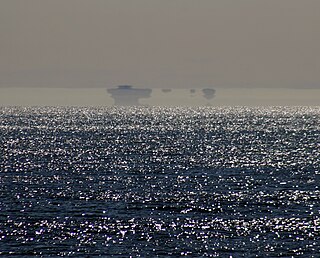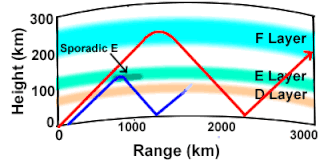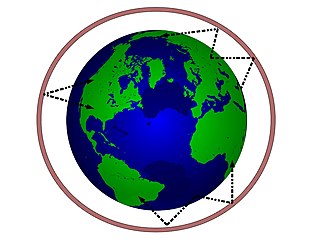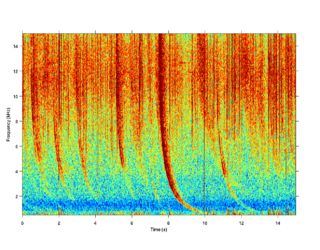Related Research Articles

The ionosphere is the ionized part of the upper atmosphere of Earth, from about 48 km (30 mi) to 965 km (600 mi) above sea level, a region that includes the thermosphere and parts of the mesosphere and exosphere. The ionosphere is ionized by solar radiation. It plays an important role in atmospheric electricity and forms the inner edge of the magnetosphere. It has practical importance because, among other functions, it influences radio propagation to distant places on Earth. It also affects GPS signals that travel through this layer.

In telecommunications, an atmospheric duct is a horizontal layer in the lower atmosphere in which the vertical refractive index gradients are such that radio signals are guided or ducted, tend to follow the curvature of the Earth, and experience less attenuation in the ducts than they would if the ducts were not present. The duct acts as an atmospheric dielectric waveguide and limits the spread of the wavefront to only the horizontal dimension.

The High-frequency Active Auroral Research Program (HAARP) is a University of Alaska Fairbanks program which researches the ionosphere – the highest, ionized part of Earth's atmosphere.

A geomagnetic storm, also known as a magnetic storm, is temporary disturbance of the Earth's magnetosphere caused by a solar wind shock wave.

Medium frequency (MF) is the ITU designation for radio frequencies (RF) in the range of 300 kilohertz (kHz) to 3 megahertz (MHz). Part of this band is the medium wave (MW) AM broadcast band. The MF band is also known as the hectometer band as the wavelengths range from ten to one hectometers. Frequencies immediately below MF are denoted as low frequency (LF), while the first band of higher frequencies is known as high frequency (HF). MF is mostly used for AM radio broadcasting, navigational radio beacons, maritime ship-to-shore communication, and transoceanic air traffic control.

A whistler is a very low frequency (VLF) electromagnetic (radio) wave generated by lightning. Frequencies of terrestrial whistlers are 1 kHz to 30 kHz, with maximum frequencies usually at 3 kHz to 5 kHz. Although they are electromagnetic waves, they occur at audio frequencies, and can be converted to audio using a suitable receiver. They are produced by lightning strikes where the impulse travels along the Earth's magnetic field lines from one hemisphere to the other. They undergo dispersion of several kHz due to the slower velocity of the lower frequencies through the plasma environments of the ionosphere and magnetosphere. Thus they are perceived as a descending tone which can last for a few seconds. The study of whistlers categorizes them into Pure Note, Diffuse, 2-Hop, and Echo Train types.

Sporadic E is an unusual form of radio propagation using a low level of the Earth's ionosphere that normally does not refract radio waves.
Radio propagation is the behavior of radio waves as they travel, or are propagated, from one point to another in vacuum, or into various parts of the atmosphere. As a form of electromagnetic radiation, like light waves, radio waves are affected by the phenomena of reflection, refraction, diffraction, absorption, polarization, and scattering. Understanding the effects of varying conditions on radio propagation has many practical applications, from choosing frequencies for amateur radio communications, international shortwave broadcasters, to designing reliable mobile telephone systems, to radio navigation, to operation of radar systems.

In radio communication, skywave or skip refers to the propagation of radio waves reflected or refracted back toward Earth from the ionosphere, an electrically charged layer of the upper atmosphere. Since it is not limited by the curvature of the Earth, skywave propagation can be used to communicate beyond the horizon, at intercontinental distances. It is mostly used in the shortwave frequency bands.
The 2-meter amateur radio band is a portion of the VHF radio spectrum that comprises frequencies stretching from 144 MHz to 148 MHz in International Telecommunication Union region (ITU) Regions 2 and 3 and from 144 MHz to 146 MHz in ITU Region 1 . The license privileges of amateur radio operators include the use of frequencies within this band for telecommunication, usually conducted locally with a line-of-sight range of about 100 miles (160 km).
Earth–Moon–Earth communication (EME), also known as Moon bounce, is a radio communications technique that relies on the propagation of radio waves from an Earth-based transmitter directed via reflection from the surface of the Moon back to an Earth-based receiver.

An ionosonde, or chirpsounder, is a special radar for the examination of the ionosphere. The basic ionosonde technology was invented in 1925 by Gregory Breit and Merle A. Tuve and further developed in the late 1920s by a number of prominent physicists, including Edward Victor Appleton. The term ionosphere and hence, the etymology of its derivatives, was proposed by Robert Watson-Watt.
Non-line-of-sight (NLOS) radio propagation occurs outside of the typical line-of-sight (LOS) between the transmitter and receiver, such as in ground reflections. Near-line-of-sight conditions refer to partial obstruction by a physical object present in the innermost Fresnel zone.
Amateur radio frequency allocation is done by national telecommunication authorities. Globally, the International Telecommunication Union (ITU) oversees how much radio spectrum is set aside for amateur radio transmissions. Individual amateur stations are free to use any frequency within authorized frequency ranges; authorized bands may vary by the class of the station license.

A radio atmospheric signal or sferic is a broadband electromagnetic impulse that occurs as a result of natural atmospheric lightning discharges. Sferics may propagate from their lightning source without major attenuation in the Earth–ionosphere waveguide, and can be received thousands of kilometres from their source. On a time-domain plot, a sferic may appear as a single high-amplitude spike in the time-domain data. On a spectrogram, a sferic appears as a vertical stripe that may extend from a few kHz to several tens of kHz, depending on atmospheric conditions.
The Earth–ionosphere waveguide refers to the phenomenon in which certain radio waves can propagate in the space between the ground and the boundary of the ionosphere. Because the ionosphere contains charged particles, it can behave as a conductor. The earth operates as a ground plane, and the resulting cavity behaves as a large waveguide.
This is an index to articles about terms used in discussion of radio propagation.
The impact of the solar wind onto the magnetosphere generates an electric field within the inner magnetosphere - the convection field-. Its general direction is from dawn to dusk. The co-rotating thermal plasma within the inner magnetosphere drifts orthogonal to that field and to the geomagnetic field Bo. The generation process is not yet completely understood. One possibility is viscous interaction between solar wind and the boundary layer of the magnetosphere (magnetopause). Another process may be magnetic reconnection. Finally, a hydromagnetic dynamo process in the polar regions of the inner magnetosphere may be possible. Direct measurements via satellites have given a fairly good picture of the structure of that field. A number of models of that field exists.
One way of outlining the subject of radio science is listing the topics associated with it by authoritative bodies.
The 8 meter band (40 MHz) is at present the lowest portion of the very high frequency (VHF) radio spectrum allocated to amateur radio use. The term refers to the average signal wavelength of 8 meters.
References
- J. H. Dellinger, "Observations on Long-Delay Radio Echoes," ST, 8, 42, 88 (1934).
- K. C. Budden, C. C. Yates, "A Search for Radio Echoes of Long Delay," Journal of Atmospheric and Terrestrial Physics, 2, 272-281 1952).
- O. G. Villard, Jr., A. F. Fraser-Smith, R. T. Cassan, "LDE's, Hoaxes, and the Cosmic Repeater Hypothesis,,' ST, 55, 54-58 (1971)
- A. T. Lawton, S. J. Newton, "Long Delayed Echoes: The Search for a Solution," Spaceflight, 16, 181-187, 195 (1974).
- George Sassoon, "A Correlation of Long-Delay Radio Echoes and the Moon's Orbit," Spaceflight, 16, 258-264 (1974).
- O. G. Villard (W6QYT), D. B. Muldrew, and F. W. Waxham (K7DS), "The magnetospheric echo box - A type of long-delayed echo explained," QST, Oct. 1980, pp. 11–14.
- G. T. Goldstone and G. R. A. Ellis, "Observations of 1.91 MHz echoes from the magnetic conjugate point after propagation through a magneto-ionic duct," Proceedings of the Astronomical Society of Australia, vol. 6, no. 3, 1986, p. 333-335
- Ellis, G. R. A. and G. T. Goldstone, "Observations of long delayed echoes", Journal of Atmospheric and Terrestrial Physics, v49 #10 (1987) pp. 999–1005.
- P. Martinez (G3PLX), "Long Delayed Echoes, A Study of Magnetospheric Duct Echoes 1997-2007," Radcom, Oct 2007, pp. 60–63.
- Duncan A. Lunan, "Space Probe from Epsilon Boötis" Spaceflight, 16:122-31 (April 1973)
- Muldrew, D. B., Generation of long delay echoes, Journal of Geophysical Research, vol. 84, 5199–5215, 1979.